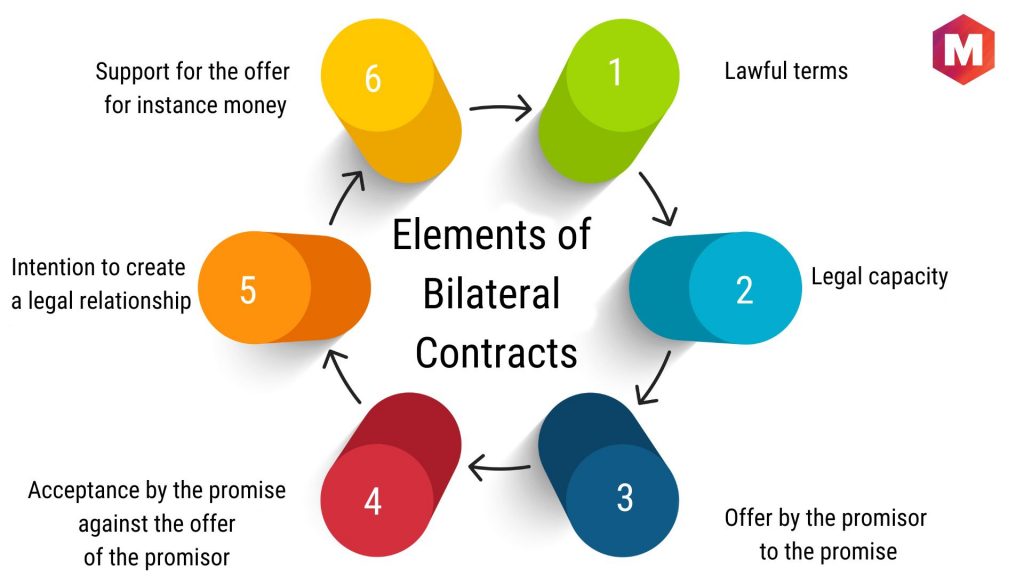
Bilateral Contracts: Elements, Enforcement and Examples

Bilateral contracts are legally binding agreements between two parties, and can be oral or written They require lawful terms, legal capacity, an offer by the promisor, acceptance by the promise, intention to create a legal relationship, and support for the offer Unlike unilateral contracts, bilateral contracts involve mutual promises Examples include employment contracts and sales agreements
A bilateral contract is a legally binding agreement between two parties that can be either oral or written. Unlike a unilateral contract where only one party is legally bound, both parties in a bilateral contract are bound to fulfill their contractual obligations. It should be noted that there are also multilateral contracts, which we will not discuss in this article. Bilateral contracts can take on various forms and can be created or enforced through different means.
What is a Bilateral Contract?
A legal obligation is created on both sides when two or more parties agree to a bilateral contract. The term "bilateral" refers to the fact that there are at least two parties involved, while the term "contract" implies that the agreement is legally binding. The three key components of a bilateral contract are: (1) offer and acceptance; (2) consideration; and (3) a legal purpose or objective.
A bilateral agreement is commonly upheld by the legal system either through specific performance, which requires the party to fulfill their contractual obligations as ordered by the court, or through compensation for breach of contract, where the court awards monetary damages to the affected party to compensate for the losses incurred.
Understanding of Bilateral Contract
During a multinational trade agreement, a bilateral contract may be formed between the parties involved. This contract is separate from the general agreement and negotiations and is relevant only to the mutual exchange and shared interest of the concerned parties. Bilateral contracts are clear, binding, and legally enforceable. An example of a bilateral contract is a sales agreement where one party offers to sell a product and the other party pays in cash for that specific product.
Many of the transactions we engage in on a daily basis are bilateral in nature, even without a legal contract. However, business contracts are inherently bilateral as they involve the exchange of a product or service for a predetermined amount of money.
A company forms bilateral agreements with both its suppliers and employees. In the case of employment contracts, the company promises to pay the employee a certain wage in exchange for completing specific tasks.
Elements of Bilateral Contracts
In legal terms, a bilateral contract is simply a promise for a promise. It involves two parties agreeing to fulfill certain obligations. This type of contract is commonly used in everyday transactions such as buying and selling goods or services. For instance, when you purchase a car, the seller agrees to transfer ownership of the vehicle in exchange for payment.
A bilateral contract has three elements:
1. Lawful terms
Both parties involved in the transaction must come to a mutual agreement on legally binding terms, which can be enforced by a reputable attorney or law firm. These terms may consist of specifics such as the type of vehicle being sold and its corresponding cost.
2. Legal capacity
Both parties entering into an agreement must possess the capacity to comprehend the terms and conditions of the agreement and make autonomous decisions without being coerced or influenced by external factors such as parental pressure or societal norms.
3. Offer by the promisor to the promise
This involves one party making an offer to another party who accepts that offer by making a promise back to them (for example, saying “I’ll take your offer”).
4. Acceptance by the promise against the offer of the promisor
The contracting parties must agree on what the legal services they are going to provide each other and then make an agreement to fulfill their promises.
5. Intention to create a legal relationship
This means that both parties have agreed to make legal documents to create a legal relationship between themselves and have agreed on the terms of this relationship.
6. Support for the offer for instance money
There must be a consideration from one party in order for there to be an enforceable contract.
Difference Between Unilateral and Bilateral Contracts
In contrast to unilateral contracts, bilateral contracts involve a mutual agreement between two parties, where both parties are obligated to fulfill their responsibilities in order to be legally bound. This differs from unilateral contracts where only one party is required to fulfill their obligations.
When you hire someone to do a job for you, they are bound by a bilateral contract to complete the task. However, when you purchase something from someone, there is no obligation on their part to provide any further services or support; they are simply selling the item to you. Additionally, bilateral contracts tend to be more complex as both parties are responsible for their respective actions, while unilateral contracts are straightforward as only one party is obligated to fulfill their end of the agreement.
Examples of a Bilateral Contract
However, these agreements only become legally binding once they are documented in a formal contract. Without a legal contract, there is no guarantee that both parties will fulfill their obligations and disputes may arise. Therefore, it is important to have a written agreement in place to protect both parties and ensure that the terms of the agreement are clear and enforceable.
While these agreements may be referred to as bilateral, they differ from bilateral contracts as they do not require a signed agreement with the other party. In the event that a party, such as a bookstore owner, refuses to sell a book, legal action cannot be taken. An example of a binding bilateral contract would be Harry agreeing to sell his car to Tom for $5000 and upon delivery, Tom pays the agreed amount. This type of contract involves both parties making promises to one another.
However, Jack fails to inform Peter about the change of plans and does not give him possession of the house. This leaves Peter in a difficult situation as he has already paid the agreed-upon amount.
Peter was left disappointed as Jack refused to sell the house to him, despite having a legal contract in place. This refusal was seen as a breach of contract, giving Peter the right to pursue legal action and sue Jack for his non-compliance with the agreement.
Enforcement of Bilateral Contract
In the above example, Peter needs to prove the following-
A contract exists between both the parties
The terms of the contract have been broken
One party has suffered a loss due to the breach of contract
The party that is being sued is responsible for the loss.
Having a contract in place between Jack and Peter would have given Peter the ability to legally pursue Jack for breach of promise. It's always recommended to formalize agreements through contracts, especially when the terms are significant, in order to ensure accountability and enforceability in case of non-compliance.










